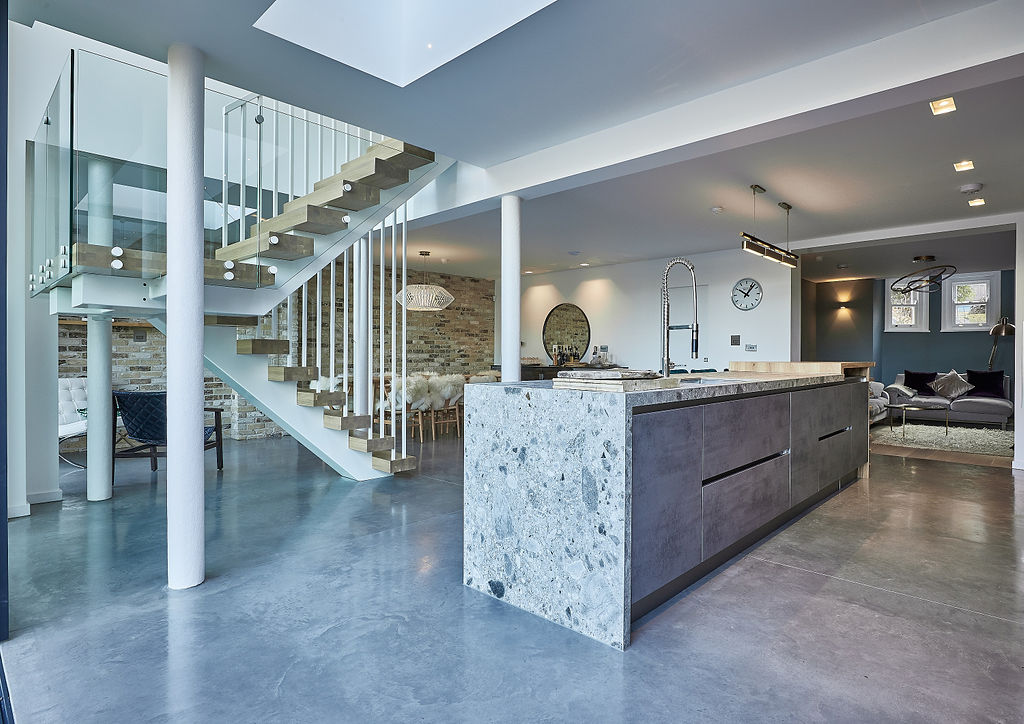Open stairways to living areas – fire safety (Part B) considerations
If you want your ground floor to be totally open plan, there are key consideration in terms of Building Regulations are the associated fire safety issues.
Part B of the Approved Documents gives guidance on how to meet the Building Regulations in England and Wales. The Approved Document gives common situations but also explains that, ‘…because the approved documents cannot cater for all circumstances, variations and innovations…where the guidance in the approved document has not been followed…the person carrying out building works should demonstrate that the requirements of the regulations have been complied with by some other acceptable means or method.’
Essentially, this is providing the opportunity to propose alternative solutions, where the rigid guidelines otherwise prohibit your design proposal. Your architect will be able to help you put together your proposed solutions and present it to building control for approval. Getting advice from a fire engineer would also be helpful and ensure your solution will be acceptable.
Using an Approved Inspector instead of the local authority building control can also allow for more flexibility to meet building regulations requirements. See below and the following article, The Advantages of using an Approved Inspector.
Open plan image above from Kim, interior designer on Design for Me. See more of her work and shortlist her for your home project here.
Inner-rooms
Open-plan layouts can result in what are known as ‘inner-rooms’. These are rooms which can only be reached by another room (as opposed to directly from a corridor). Inner-rooms pose a risk. Say you have a living room that can only be accessed via a kitchen. If a fire starts in the kitchen, there is no safe route to escape from the living room. This would be unacceptable to Building Control, unless an acceptable alternative solution is presented to overcome the risk.
Emergency Escape Windows and Doors
One solution to the above is to provide an alternative exit for the occupant, such as a door or window from within the ‘inner-room’. Emergency escape windows or doors should comply with 2.10 of Approved Document B. In addition to other criteria, this gives detail on the minimum unobstructed openable area (0.33m2), a minimum and maximum height of 450mm.
Protected stairways and means of escape in houses
Section 2 of Approved document B1 (dwellings) deals with means of escape and is essential to consider in terms of your renovation plans. The more storeys your house has, the more stringent the rules are around escape.
Sprinkler and misting systems
An alternative option to some of the means of escape rules could be sprinklers or misting systems. The idea is that the escape route is protected for longer. Misting systems are more commonly considered to be a better, cheaper alternative to sprinklers, particularly in renovations as the system can be retro-fitted.
If your proposal includes open plan living arrangements, seek the input from a fire engineer. They can suggest ways to help you achieve your open plan design and provide a report to Building Control to strengthen your case for approval.
Structural considerations
If you’re planning to remove structural walls, you will need to provide alternative support, e.g. by way of beams and columns. While almost anything is possible structurally, what you choose to do may come down to cost. Speak to a structural engineer right at the beginning of the design phase (ask your architect – they will often have one they usually work with). A structural engineer will be able to advise on cost implications, and during the design development phase they will specify the structural elements of the build.
Do you need planning permission to go open-plan?
Unless it’s part of a change of use development, or the building is listed, you wouldn’t usually need planning permission to remove internal walls. You might, however, if you alter the external appearance of the house.
Should I use the Local Authority or an Approved Inspector?
As mentioned above, using an Approved Inspector (instead of the local authority) can result in a more flexible approach and more innovative solutions can be achieved. See our full article on the advantages of using an Approved Inspector.
Speak to an architect
Information contained in this article is for general information only. You architect can help you to navigate the compliance with the Building Regulations and the best way to gain Building Regs approval for your particular project.
Design for Me helps homeowners find the best residential architects for their home building or renovation projects, all over the UK.
Once you register your project, we’ll match it with the best architects in your area and beyond, and you can see who may be available and eager to work on your project straight away.
- Quickly see who’s interested in your job.
- Create a shortlist.
- Invite up to three for a no-obligation consultation.
Emily Design for Me

